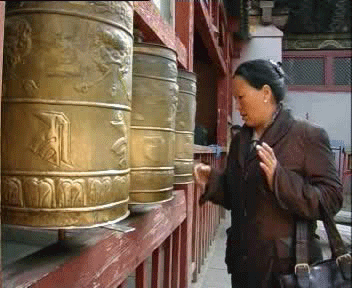
Buddhism was repressed in Mongolia for several decades under the Soviet-era where freedom of religion was severely curtailed.
But the religion has witnessed a revival in recent years.
In the Mongolian capital, Ulaanbaatar is one of the country’s most important Buddhist monasteries.
It is known as Gandantegchinlen, which means “the great place of complete joy.”
Built in 1838, it is now frequented by believers praying for good health, good luck, and even better business and marital prospects.
Mongolia is home to the Tibetan brand of Buddhism, and Ganden is one of the few monasteries to have survived the country’s recent turbulent history.
When the reign of the Manchus ended in 1911, Buddhism was a powerful religious and even economic and political force.
But under Soviet domination, nearly all of the country’s monasteries were wiped out, their properties seized, and countless monks sent to labour camps in Siberia.
In a land where Buddhism had often flourished, the religion came under severe persecution by the then Soviet Union from the 1930s through to the 1960s.
Even though the true extent and magnitude of the horrors can never be known, historians have, in recent years, uncovered numerous graveyards in which Buddhist monks had earlier been purged and executed.
The religion underwent a revival after the downfall of the Soviet Union, and many monasteries were either built or restored.
In 1992, freedom of religion was guaranteed in the constitution, and people started flocking back to monasteries.
One Mongolian said : “My grandfather and mother were devout Buddhists. When I was a child I would learn about Buddhism. So I believed in it since I was very young.”
Another Mongolian said: “It’s a Mongolian tradition to pray to our Gods and ask them to make our lives prosperous and happy.”
Gombusuren Dalantai, Ganden monastery senior monk, said: “Mongolia is one of the three main centres of Buddhism, the other two being India and Tibet.
After 1990, believers began to donate money to rebuild the monasteries. We have some old monks who began teaching Buddhism to young people. There’s a lot of interest to revive Buddhism.”
But reviving the religion hasn’t been easy, given that two generations had grown up with little knowledge of Buddhism.
Most people have little understanding of the Buddhist rituals or their meanings, and well-educated Buddhist teachers are in short supply.
Some even argue that Buddhism as practiced in Mongolia is not authentic.
Gombusuren Dalantai added: “We send many young monks to India and Tibet and Sri Lanka. There they learn and spend four to seven years.
Some of them stayed more than a decade. They come back to serve Ganden so how can they say it’s not authentic?”
The revival of Buddhism should hardly come as a surprise, given the central role of the religion in Mongolian history and culture.
Analysts even predict that the new dawn of Buddhism is likely to forge and mould a new culture and religious identity for the country.
Source : http://www.channelnewsasia.com




